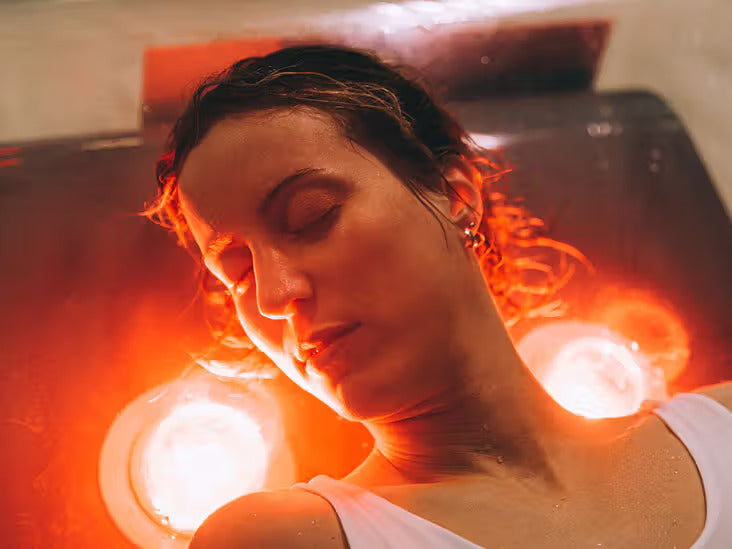
The Science: What Exactly Is a Hot Flash?
- Written by: Corentin Hugot
The Science: What Exactly Is a Hot Flash?
By Alicia Wallerstein
Hot flashes are a common symptom of the period leading up to menopause (perimenopause) that can be disruptive and significantly impact a woman’s quality of life. 80% of perimenopausal women report experiencing hot flashes. The brief episodes of intense heat can normally be felt on the face, chest, and neck, and are usually accompanied by reddening of the skin and profuse sweating. Although you may be easily able to identify hot flashes by their symptoms, you may not know why or how your body is making you sweat through your sheets every night. Let’s consider what body systems and parts generate a hot flash, and why menopause triggers these symptoms.
The Symptoms
Hot flashes are part of a variety of vasomotor symptoms that can be felt during perimenopause. Vasomotor symptoms are symptoms that have to do with the diameter of blood vessels (more on why the diameter is important later!). Other vasomotor symptoms and sensations that may accompany a hot flash include:
- Sweating and night sweats
- Anxiety
- Sleep disturbances
- Heart palpitations
Hot flashes can have a serious impact on your quality of life, especially if you are losing sleep to relieve your symptoms or if they are interrupting everyday activities.
Perimenopause and Oestrogen
What exactly is oestrogen? Oestrogen is one of the main female sex hormones that is primarily released from egg follicles into the blood circulation. Oestrogen is a signalling molecule, one that can relay messages and feedback to distant parts of the body, such as the brain and blood vessels. But why is this relevant to menopause?
As we know all too well, women menstruate and ovulate every month from their teen years until menopause, leading to a decrease in egg follicles. As egg follicle count decreases, so does the amount of oestrogen released from them. While the generation of a hot flash is complex and relies on signalling in the brain and signalling to blood vessels, changing oestrogen levels is considered to be the major cause for hot flashes.
The Central Nervous System and Hypothalamus
The central nervous system plays an important role in hot flashes. The central nervous system is composed of the brain and the spinal cord, and serves the function of integrating inputs from our surroundings and then generating actions. As a part of the central nervous system, the hypothalamus is a critical regulator of the body. It keeps everything in your body in balance, such as water levels or temperature.
The hypothalamus plays a major role in maintaining the core body temperature of 37°C. Our body detects its current temperature and relays this information to the hypothalamus. The range of ambient temperatures that a human can exist at without sweating or shivering is called the thermoneutral zone. Crossing the upper threshold of the thermoneutral zone leads to sweating, whereas crossing the lower threshold leads to the generation of chills. It is found that women that have a smaller thermoneutral zone are more prone to hot flashes as these thresholds are more likely to be passed. The changes in oestrogen levels associated with the transition to menopause can also change how the hypothalamus responds to temperature changes, making hot flashes more likely.
The Blood Vessels
Although we have discussed how the brain controls hot flashes, a key component remains: how does hypothalamic control translate to the redness, sweating, and heat that is so disruptive? This involves understanding vasomotor regulation, which controls the diameter of blood vessels, widening through vasodilation and narrowing through vasoconstriction.
Blood vessels use vasodilation combined with sweating to dissipate heat. For instance, after exercise, you become flushed because blood vessels dilate, increasing blood flow to the skin and heat energy transfers from the blood to the air. This gives the appearance of being red, as your red blood rushes through widened vessels to contact air. Sweating further cools the body as it takes heat energy to evaporate the sweat off your skin.
During menopause, changes in hypothalamic control make women more prone to hot flashes, where the body attempts to dissipate heat, leading to redness and sweating. After a hot flash, many perimenopausal women experience chills as the body tries to restore core temperature.
In conclusion, as thermoregulation changes during menopause, women become more susceptible to hot flashes, where the body's heat dissipation mechanisms cause the characteristic redness, sensation of heat, and sweating.
The Solutions
You can manage your hot flashes through lifestyle changes, home remedies, or medical interventions if necessary.
Lifestyle Changes
- Diet: Eat fruits, vegetables, and whole grains; avoid spicy foods, caffeine, and alcohol.
- Exercise: Aim for 30 minutes of moderate exercise most days.
- Stress: Practice yoga, meditation, or deep-breathing exercises.
Home Remedies
- Hydration: Drink plenty of water daily.
- Clothing: Wear light, breathable fabrics like cotton and layer for temperature changes.
- Room Temperature: Use a fan or keep windows open at night to stay cool.
Medical Interventions
- Over-the-Counter: Non-prescription treatments like ibuprofen can help manage discomfort.
- Prescription: For severe hot flashes, a doctor might recommend hormone therapy or other medications.
- Healthcare Provider: Consult a healthcare provider for persistent or bothersome hot flashes for appropriate treatment.
Smart Cooling Mattress Pad (Terra)
Amira’s Terra is designed to help you sleep soundly by predicting and preventing nighttime hot flashes. This innovative wearable bracelet monitors your sleep and detects tiny amounts of moisture in your skin, allowing it to anticipate an upcoming hot flash. When a hot flash is detected, the mattress pad cools down in just 5 seconds, providing immediate relief needed to sleep through the night. Terra’s smart cooling system is effective whether your hot flashes stem from menopause, stress, or other hormonal imbalances. Learn more about Terra here.
Deecher, D. C., & Dorries, K. (2007). Understanding the pathophysiology of vasomotor symptoms (hot flushes and night sweats) that occur in perimenopause, menopause, and postmenopause life stages. Archives of Women’s Mental Health, 10(6), 247–257.https://doi.org/10.1007/s00737-007-0209-5
Ferrari, N. (2015, February 23). Menopause-related hot flashes and night sweats can last for years. Retrieved from Harvard Health website:
https://www.health.harvard.edu/blog/menopause-related-hot-flashes-night-sweats-can-last-years-201502237745
Miller, V. M., & Duckles, S. P. (2008). Vascular actions of estrogens: functional implications. Pharmacological Reviews, 60(2), 210–241. https://doi.org/10.1124/pr.107.08002Peacock, K., & Ketvertis, K. M. (2022, August 11). Menopause. Retrieved from NIH website:
https://www.ncbi.nlm.nih.gov/books/NBK507826/
Rapkin, A. J. (2007). Vasomotor symptoms in menopause: physiologic condition and central nervous system approaches to treatment. American Journal of Obstetrics & Gynecology, 196(2), 97–106. https://doi.org/10.1016/j.ajog.2006.05.056

Sleep Cool, Wake Refreshed
Terra’s smart cooling system stops hot flashes before they wake you.
Predicts & cools in seconds
No noise, no interruptions
Wake up refreshed





